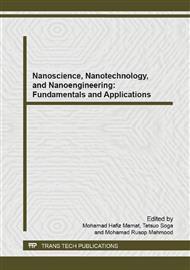p.461
p.466
p.471
p.476
p.481
p.486
p.491
p.495
p.500
Optimization of RF Magnetron Sputtering Process Parameters Based on Genetic Algorithm and Neural Network
Abstract:
A procedure for RF magnetron sputtering process parameter optimization is proposed in this paper. This study has been focusing on determining the optimal parameter combination for producing the desirable optical band gap. In this proposed procedure, Genetic Algorithm (GA) has been adapted as the optimization tool, while Artificial Neural Network (ANN) has been implemented as the prediction model. GA was adapted to search for the optimal parameter combination from the set of parameters, while later the ANN modeling had been utilized to predict the optical band gap energies for each of the parameter combinations. The result from the GA optimization is expected to produce the highest band gap value. The computational results from the proposed procedure were then compared with the actual laboratory experimental results from the ZnO thin film fabrication. Based on the comparison result, the performance of the proposed procedure had proven to be promising in determining the most optimized process parameter combination from the set of parameters.
Info:
Periodical:
Pages:
481-485
Citation:
Online since:
June 2015
Authors:
Price:
Сopyright:
© 2015 Trans Tech Publications Ltd. All Rights Reserved
Share:
Citation:


